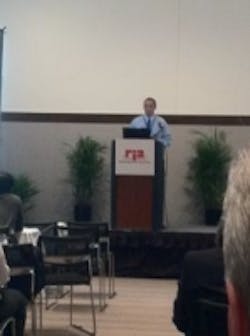[Page 2] Live from the AIA Vision show: An outlook on collaborative robots
The second of these two sessions, “Future research challenges for collaborative manufacturing robots,” was delivered by Craig Schlenoff, Cognition and Collaboration Group Leader, National Institute of Standards and Technology (NIST.) In this session, Schlenoff explained that the US is losing leadership in manufacturing, and that advanced robots couldprovide innovation across multiple industries, but it is hindered by a lack of “measurable science.” As a result, only about 10% of potential users benefit from such robots.
Schlenoff went on to address a number of additional challenges that exist when it comes to using robots in a manufacturing setting, including safety, robot design, human acceptance, autonomy/flexibility/agility, and human robot interaction. In addition to these, he identified the robot’s sensing and situational awareness abilities as a core issue. Specifically, the perception of elements, situational awareness, and intentional recognition are three fundamental issues to address when it comes to utilizing collaborative robots, suggested Schlenoff.
An important part of the presentation came at the end, when Schlenoff described what he meant by “measurable science,” concerning collaborative robots. Another core NIST focus, measurable science, or the lack thereof, increases the risk of adoption for robots. As a result, NIST is working on a number of projects in hopes of developing metrics that can be used to propagate useful information to users and developers. These projects include:
- Performance of collaborative robot systems: Working to assess and assure that robots working collaboratively will complete their assigned tasks correctly, safely, etc.
- Agility performance of robotic systems: Goals of enabling manufacturers to easily and rapidly reconfigure and retask robot systems in assembly operations.
- Allow manufacturers to reprogram robots easily: Program is working to produce metrics and test methods to measure robot agility, a robot description model, methods/protocols/information models, and an integrated agility framework.
NIST is seeking collaborations with users and developers of robots in order to gain more information in these projects and develop metrics, test methods, tools, and testbeds with prototype systems, explained Schlenoff.
View more information on the Collaborative Robots Workshop.
Also check out:
Live from the AIA Vision Show: How surveillance and security technologies protect us
AIA Vision Show preview: Machine vision solutions for a growing market
(Slideshow) 10 innovative current and future robotic applications
Share your vision-related news by contacting James Carroll, Senior Web Editor, Vision Systems Design
To receive news like this in your inbox, click here.
Join our LinkedIn group | Like us on Facebook | Follow us on Twitter | Check us out on Google +
Page 1 | Page 2
About the Author

James Carroll
Former VSD Editor James Carroll joined the team 2013. Carroll covered machine vision and imaging from numerous angles, including application stories, industry news, market updates, and new products. In addition to writing and editing articles, Carroll managed the Innovators Awards program and webcasts.

